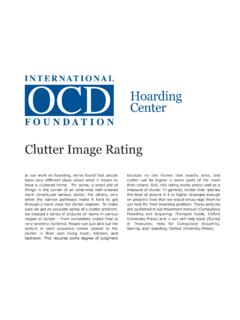Transcription of Preventing Falls: How to Develop Community-based Fall ...
1 Preventing FALLS: A Guide to Implementing Effective Community-based Fall Prevention Programs Preventing Falls: A Guide to Implementing Effective Community-based Fall Prevention Programs 2nd Edition Division of Unintentional Injury Prevention National Center for Injury Prevention and Control Centers for Disease Control and Prevention Atlanta, Georgia 2015. This document is a publication of the National Center for Injury Prevention and Control of the Centers for Disease Control and Prevention: Centers for Disease Control and Prevention Thomas R.
2 Frieden, MD, MPH, Director National Center for Injury Prevention and Control Debra Houry, MD, MPH, Director Division of Unintentional Injury Prevention Grant Baldwin, PhD, MPH, Director Home, Recreation, and Transportation Branch Ann Dellinger, PhD, MPH, Branch Chief Home and Recreation Injury Prevention Team Robin Lee, PhD, MPH, Team Lead ACKNOWLE DG E M E NTS. CDC would like to acknowledge the contributions of the Administration for Community Living (ACL) and Department of Housing and Urban Development (HUD) for their continued expertise and guidance on the development of this guide.
3 The partnership between CDC, ACL, and HUD is critical for advancing the use and uptake of effective fall prevention programs that can help safeguard the health of older Americans. Suggested Citation: National Center for Injury Prevention and Control. Preventing Falls: A Guide to Implementing Effective Community-based Fall Prevention Programs. 2nd ed. Atlanta, GA: Centers for Disease Control and Prevention, 2015. Disclaimer: Reference herein to any specific commercial products, programs, or services by trade name, trademark, manufacturer, or otherwise, does not necessarily constitute or imply its endorsement, recommendation, or favoring by the United States Government.
4 The views and opinions of authors expressed herein do not necessarily state or reflect those of the United States Government, and shall not be used for advertising or product endorsement purposes. iv CONTENTS. Chapter 1. Introduction .. 1. Why fall prevention is important .. 2. Understanding fall risk factors .. 3. Effective interventions can prevent older adult falls .. 4. Purpose of this guide .. 4. Chapter 2. Planning for a Fall Prevention Program .. 7. Determine your community's needs .. 7. Identify resources.
5 8. Determine your organization's readiness .. 8. Selected web resources .. 9. Chapter 3. The Important Role of Partnerships .. 11. Developing partnerships .. 11. Maintaining partnerships .. 12. Building an infrastructure .. 13. Budget adequate resources .. 13. Selected web resources for developing partnerships .. 14. Chapter 4. Selecting an Evidence-Based Fall Prevention Program .. 15. What is an evidence-based program? .. 15. Community fall prevention programs .. 15. Selecting a program .. 16. Program characteristics.
6 17. Selected program web resources .. 18. Chapter 5. Raising Awareness about Your Program .. 19. Reaching your intended audience .. 19. Increasing public awareness .. 19. Developing a plan .. 20. Provider education .. 20. Public education .. 21. Selected fall prevention education web resources .. 22. Chapter 6. Implementing Your Fall Prevention Program .. 23. Identify your target audience .. 23. Think collaboratively .. 24. Recruiting program participants .. 26. Assuring program quality .. 27. v Appendix E Template for Developing a Sustainability Plan A GUIDE TO IMPLEMENTING EFFECTIVE Community-based FALL PREVENTION PROGRAMS.
7 Program fidelity .. 27. Continuous quality improvement (CQI) .. 29. Selected implementation web resources .. 29. Chapter 7. Evaluating Your Fall Prevention Program .. 31. Introduction .. 31. Why evaluate? .. 32. Measuring program effectiveness .. 32. Goals .. 33. Evaluation methods .. 33. Types of data .. 34. Types of evaluation .. 35. Determining which method to use .. 36. Selected evaluation web resources .. 37. Chapter 8. Promoting Your Fall Prevention Program .. 39. Conducting a successful campaign .. 39. Working with the media.
8 41. Selected promotional web resources .. 42. Chapter 9. Sustaining Your Fall Prevention Program .. 43. Establish your vision .. 43. Build collaborations .. 44. Secure funding .. 44. Demonstrate benefits .. 45. Delivery infrastructure .. 45. Strategies for achieving financial sustainability .. 45. Selected sustainability web resources .. 47. Appendices .. 49. Appendix A Stay Independent brochure .. 49. Appendix B Educational Materials for Older Adults .. 50. What YOU Can Do to Prevent Falls A fall prevention brochure.
9 50. Check for Safety A home safety checklist .. 50. Exercise & Physical Activity Book .. 51. Appendix C Sample Letter to a Health Care Provider for Referrals .. 52. Appendix D Program Evaluation Checklist .. 53. Appendix E Template for Developing a Sustainability Plan .. 56. vi Chapter 1. Introduction CHAPTER 1. Introduction Falls are the leading cause of fatal and nonfatal injuries among adults 65 and older and 10,000 people in the United States turn 65 every day. Community-based organizations (CBOs) play an important role in promoting the health and well-being of the residents in their community.
10 Many of the services provided by CBOs like yours help people of all ages maintain healthy lifestyles and improve their quality of life. This includes expanding efforts to reduce falls among older adults. CBOs who want to prevent falls recognize that they must offer effective evidence-based fall prevention programs. However, choosing a fall prevention program that is appropriate for clients, readily available with training and tools in place, and affordable can be a daunting task. The purpose of this guide is to provide information to help CBOs choose and implement evidence-based fall prevention programs based on their organization's goals and clients'.











